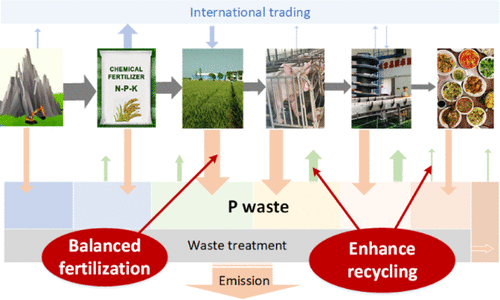当前位置:
X-MOL 学术
›
Environ. Sci. Technol.
›
论文详情
Our official English website, www.x-mol.net, welcomes your
feedback! (Note: you will need to create a separate account there.)
Historic Trends and Future Prospects of Waste Generation and Recycling in China's Phosphorus Cycle.
Environmental Science & Technology ( IF 10.8 ) Pub Date : 2020-04-01 , DOI: 10.1021/acs.est.9b05120 Xuewei Liu 1 , Zengwei Yuan 1 , Xin Liu 1 , You Zhang 1 , Hui Hua 1 , Songyan Jiang 2
Environmental Science & Technology ( IF 10.8 ) Pub Date : 2020-04-01 , DOI: 10.1021/acs.est.9b05120 Xuewei Liu 1 , Zengwei Yuan 1 , Xin Liu 1 , You Zhang 1 , Hui Hua 1 , Songyan Jiang 2
Affiliation

|
Intensified human activities have generated a large amount of phosphorus-containing waste (P waste). Unrecycled P waste is lost to the environment and causes eutrophication, while the increasing phosphate consumption risks the depletion of phosphorus resources. The management of P waste is critical to solving these problems. In this study, we quantified the historic trends of P waste generation and recycling in China. From 1900 to 2015, the annual generation of P waste increased from 1 Mt P to 12 Mt P. Crop farming was the largest P waste source in most years, while P waste from phosphate mining and phosphorus chemical production increased the fastest. The total recycled P waste increased 5-fold, but phosphorus loss increased 26-fold. In 2015, 28% of the P waste was lost on cultivated land, and 21% was lost on nonarable land. The largest phosphorus contributor to inland water changed from crop farming to aquaculture. The full recycling of P waste would have reduced phosphate consumption by more than one-third in 2015. The results of a scenario analysis showed that a healthier diet would greatly increase the generation and loss of P waste, but balanced fertilization could reduce the generation of P waste by 17% and promoting waste recycling could reduce the phosphorus loss by 35%.
更新日期:2020-04-23









































 京公网安备 11010802027423号
京公网安备 11010802027423号